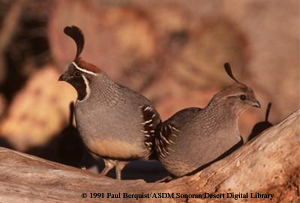Animal Fact Sheet: Gambel's Quail |
Identifying Features Gambel's quail (Callipepla gambelii) have a chunky round body with a feather plume on their head. Males have a dark and thick plume, a black face, neck and also a black patch on the breast. Females have more dull and thin feather plumes and lack the black markings. Mature males have much more striking plumage than females. |
 |
Adaptations Gambel's quail have the ability to select green foods in sufficient quantity to provide nutrition, but also to obtain the moisture they need. The ability to adapt its food choices to seasonal changes allow it to survive in the arid desert environment. |
Habitat Gambel's Quail live in warm deserts with brushy and thorny vegetation. These birds also survive well in cultivated communities and prefer mesquite lined river valleys and drainage's near these lands. Desert mountain foothills, mesquite springs, plains with diverse vegetation and any area of the desert receiving slightly more rainfall than surrounding parts, are all home to good populations of Gambel's quail. |
Range Gambel's quail are found almost exclusively in the southwestern United States, mainly in Arizona. Their range extends into Mexico, east to parts of Texas, west to California and a small part of southern Utah, Nevada and Colorado. A few quail were introduced to Hawaii in 1928, 1958 and 1960, and a few remain there today. |
Wild Status Currently, there is no significant conservation effort to aide the Gamble's quail, but the bird is doing very well. Habitat degradation from urbanization and cattle grazing are possible threats to the bird. The Gambel's quail is an extremely popular game bird and there are few hunting restrictions. |
Diet Ninety percent of the Gambel's Quail diet comes from plants. Various types of seeds and leaves are eaten throughout the year. During certain times of year fruits and berries from cacti are eaten. A few insects are eaten during the nesting season in spring and early summer. |
Predators These quail prefer to remain motionless and rely on camouflage to avoid predators, especially if hidden by vegetation. They are preyed on by a wide diversity of small to medium predators including snakes, raptors, foxes, bobcats, and coyote. |
Home Gambel's quail prefer to roost in dense shrubs or trees at night. Shade from various types of desert vegetation is also very helpful. Dense cover provides shelter from predators. Female quail usually select nest sites on the ground. Preferably the nest is hidden under a shrub, rock, or protected site. Small twigs, grass stems, leaves and feathers line the nest. |
Life Span Average life expectancy for a wild quail is 1.5 years although on occasion they may live for up to four years. |
Size Mature birds average eleven inches long and weigh from 5.1 to 6.5 ounces (160 to 200 grams.) |
Extra Fun-facts
|
 ©Copyright 2008, Arizona-Sonora Desert Museum
©Copyright 2008, Arizona-Sonora Desert Museum